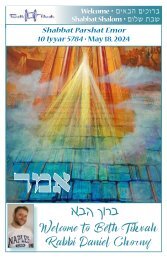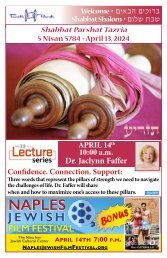Create successful ePaper yourself
Turn your PDF publications into a flip-book with our unique Google optimized e-Paper software.
Welcome • ohtcv ohfurc<br />
Shabbat Shalom • ouka ,ca<br />
Shabbat Parshat Beha’alotcha<br />
16 Sivan 5784 • June 22, 2024<br />
l`ukgvc<br />
Sponsor a<br />
Kiddush<br />
Contact Arleen Sivakoff:<br />
dsivakoff@aol.com • 239.455.8811
Yahrtzeiten<br />
June 21<br />
June 24<br />
June 26<br />
June 27<br />
June 28<br />
Anniversaries<br />
Benjamin Kaye<br />
Richard Rosen<br />
Gail Nizin, Christine Portnoy, Judith Lipnick<br />
Rene Geist<br />
Helen Mena<br />
June 22 Eileen & Howard Jacobs (44)<br />
June 23 Ellaine & Richard Rosen (61)<br />
Anat & Evan Kuperman (22)<br />
June 26 Belle & Ron Agronin (64)<br />
vfrck oburfz<br />
June 24 • 18 Sivan Paul Agronin – Brother of Ronald Agronin<br />
Clara Hecht – Relative of Arnold Bresnick<br />
June 25 • 19 Sivan Max Hecht – Father-in-law of Arnold Bresnick<br />
Gordon Field – Father of Jay Kaye<br />
Birthdays<br />
jna `skuv ouh<br />
cuy kzn
Torah & Haftarah Readings:<br />
Shabbat Beha’alotcha: Numbers 9:15–10:34 (Cycle 2) (Etz Hayim p. 821)<br />
1. 9:15-18 2. 9:19-23 3. 10:1-7 4. 10:8-10<br />
5. 10:11-20 6. 10:21-28 7. 10:29-34 M. 12:14-16 (p. 835)<br />
Haftarah: Zechariah 2:14–4:7 (p. 837)<br />
Torah Commentary<br />
D’var Torah:<br />
Get Moving!<br />
When we think about how we observe Jewish rituals, very often<br />
we only think about using our minds, or maybe our mouths<br />
uttering prayers. But we usually don’t think about other ways that<br />
we engage our bodies in ritu-als. In Parshat Behalotcha we read an<br />
interesting section describing how the Levites have to prepare to<br />
carry the holy items in the Mishkan by both washing and shaving<br />
their bodies. We typically would not think of shaving as a ritual<br />
act, but here it was. And I think that our ancient ancestors would<br />
be much more comfortable thinking about embodied rituals<br />
because they did them a lot. When they prayed they moved their<br />
arms in certain ways.<br />
They had multiple different ways of bowing. When they brought<br />
offerings to the Temple they would wave them or raise them up.<br />
When they were in mourning they would put ash on their heads<br />
and wrap their entire head in a turban. Those might seem strange<br />
to us, but we don’t have to dig too deeply to remember that we<br />
have some embodied rituals still in practice today. We still bow<br />
when we pray, and for those who make a full prostration down<br />
to the ground on the High Holidays, you know how different<br />
that feels than just a knee bend. When we bless our children we<br />
lay our hands on their heads. When we light Shabbat candles we<br />
wave our hands three times and cover our eyes. And I’m sure that<br />
you can think of more.<br />
While Judaism may focus on the mind and spirit, we are still<br />
connected to our bodies while we are alive, and we can use our<br />
bodies to elevate our spirit. Each ritual that involves a bodily<br />
action can help us understand that ritual that much more deeply.
Synopsis of the Haftorah:<br />
The message in this week’s haftorah form the Book of Zechariah<br />
centers on God’s promise of restoration and divine presence among<br />
His people. The passage begins with a call for rejoicing as God declares<br />
His intention to dwell in Zion, bringing together many nations as His<br />
people. This highlights the inclusive nature of God’s salvation and His<br />
commitment to live among His followers, fostering a relationship based<br />
on His holiness and their reverence.<br />
The subsequent vision of Joshua the high priest underscores the<br />
themes of forgiveness and redemption. Joshua, initially clothed in filthy<br />
garments symbolizing sin, is cleansed and given clean attire, signifying<br />
God’s willingness to forgive and restore His people. The prophecy of<br />
the coming servant, the Branch, who will remove iniquity and usher in<br />
peace, points to a future hope rooted in God’s redemptive plan.<br />
Lastly, the vision of the golden lampstand and the two olive trees<br />
reinforces the idea that God’s work, including the rebuilding of the<br />
temple, will be achieved through His Spirit, not by human strength.<br />
This emphasizes reliance on divine power for accomplishing God’s<br />
purposes and the role of divinely anointed leaders in guiding His<br />
people. Collectively, these verses convey a message of hope, renewal,<br />
and the transformative power of God’s presence and Spirit in the lives<br />
of His people.<br />
Join ✺ Rabbi Chorny<br />
for his weekly discussion<br />
group, Tuesdays at<br />
12:15 p.m. via<br />
and IN Person<br />
Beth Tikvah of Naples<br />
1459 Pine Ridge Road<br />
Naples, FL 34109<br />
239 434-1818<br />
Visit us online at<br />
bethtikvahnaples.org<br />
or scan the QR code

















